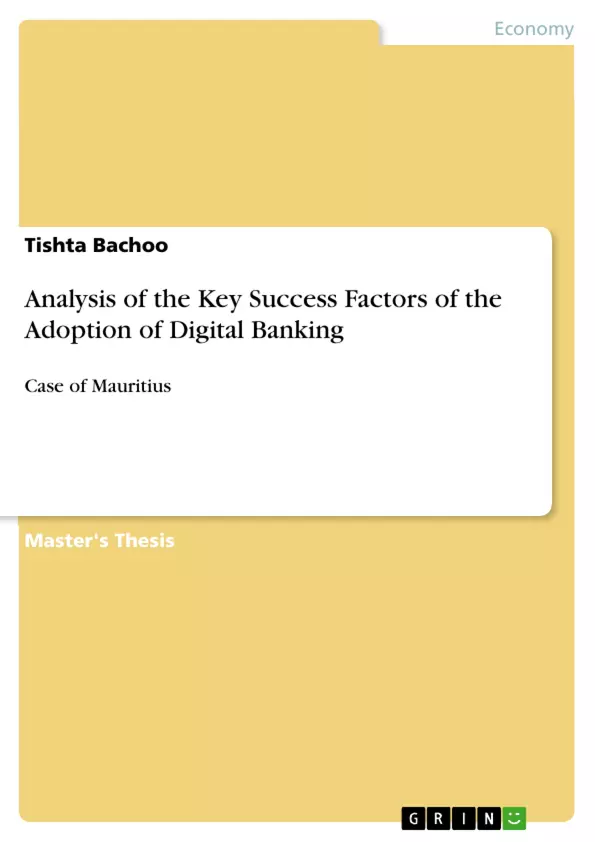Data Innovation is gradually changing the banking industry around the world. Digital banking offers banks new opportunities and challenges. This paper gives a comprehension of how demographic characteristics, social components and consumer perception and attitudes towards digital banking influence its adoption. Digital banking has been developed in order to enable consumers to gain a greater share in the banking market. In Mauritius, there is little awareness about the emergence of digital banking despite the fact that this service is presently representing an important share in the banking market. This is because digital banking is a new industry here, and therefore, consumer acceptance and use of digital banking is still limited. To date, very little research has been conducted into factors which influence consumer adoption of digital banking in Mauritius, and so, therefore, there is a need for a study such as this.
A research framework in light of the diffusion of innovation theory was utilized to identify elements that would impact the adoption of digital banking. This report has evaluated current literature and conclusions about this innovation banking technology. It has likewise reviewed the elements, including consumer demographic characteristic, consumer perceptions towards digital banking and social impacts that influence consumer adoption of this mode of banking.
This study additionally clarifies the strategy utilized as a part of conducting a survey of 25 questions with 185 respondents to acquire primary data for this study. Analysis of these outcomes was made with charts and figures to determine to what extent the factors studied, influence consumer adoption of digital banking. The hypotheses of this research were tested with chi-square tests.
Inhaltsverzeichnis (Table of Contents)
- CHAPTER 1 - INTRODUCTION
- 1.1 BACKGROUND OF THE STUDY
- 1.2 DEFINITION OF DIGITAL BANKING
- 1.3 THE EVOLUTION OF BANKING SECTOR IN MAURITIUS.
- 1.4 PROBLEM DEFINITION.
- 1.5 RATIONAL OF STUDY
- 1.6 AIMS, OBJECTIVES, RESEARCH QUESTIONS AND HYPOTHESIS
- 1.6.1 RESEARCH OBJECTIVES
- 1.6.2 RESEARCH QUESTIONS
- 1.6.3 RESEARCH HYPOTHESES.
- 1.7 STRUCTURE OF DISSERTATION.
- CHAPTER 2 – LITERATURE REVIEW
- 2.1 THE DIGITAL BANKING ECOSYSTEM.
- 2.2 DIGITAL BANKING IN MAURITIUS
- 2.3 DIGITAL BANKING FROM THE CUSTOMER PERSPECTIVE.
- 2.4 KEY SUCCESS FACTORS
- 2.5 ADOPTION MODEL
- 2.5.1 TECHNOLOGY ADOPTION MODEL (TAM).
- 2.5.2 EXTENSION OF TAM TOWARDS E-TAM
- 2.5.3 DIFFUSION OF INNOVATIONS THEORY (DIT) ..
- 2.5.3.1 CONVENIENCE, ACCESSIBILITY AND QUICK ONLINE SERVICE DELIVERY.
- 2.5.3.2 E-SECURITY, PRIVACY AND TRUST.
- 2.5.3.3 CONTENT, DESIGN AND SIMPLICITY OF THE BANKING WEB SITE.
- 2.5.3.4 ANXIETY AND RELIABILITY.
- 2.5.3.5 FEES AND CHARGES
- 2.5.3.6 DEMOGRAPHIC CHARACTERISTICS
- 2.5.3.7 BEHAVIORAL INTENTION
- 2.5.3.8 ACTUAL USAGE
- 2.6 CHAPTER SUMMARY
- CHAPTER 3 - METHODOLOGY
- 3.1 INTRODUCTION
- 3.2 RESEARCH METHODS
- 3.2.1 EXPLANATORY RESEARCH
- 3.2.2 DESCRIPTIVE RESEARCH
- 3.3 DATA COLLECTION INSTRUMENTS..
- 3.3.1 SECONDARY DATA COLLECTION.
- 3.3.2 PRIMARY DATA COLLECTION.
- 3.4 THE POPULATION AND SAMPLE SIZE
- 3.4.1 SAMPLE SIZE
- 3.5 PILOT TESTING
- 3.6 LIMITATIONS AND DIFFICULTIES.
- 3.7 RESPONSE RATE
- 3.8 DATA PREPARATION AND CODING..
- 3.9 ANALYSIS OF DATA.
- CHAPTER 4 – PRESENTATION AND ANALYSIS OF FINDINGS
- 4.1 PRESENTATION OF FINDINGS
- 4.1.1 SECTION 1- BANKING INFORMATION
- 4.1.2 SECTION 2- BANKING SERVICES.
- 4.1.3 SECTION 3- PERCEPTIONS OF DIGITAL BANKING
- 4.1.3.1 THE RELATIVE ADVANTAGES OF DIGITAL BANKING.
- 4.1.3.2 THE COMPLEXITY OF INTERNET BANKING......
- 4.1.3.3 THE COMPATIBILITY OF DIGITAL BANKING
- 4.1.3.4 THE PERCEIVED COST OF DIGITAL BANKING
- 4.1.3.5 THE PERCEIVED RISK OF DIGITAL BANKING
- 4.1.3.6 INFLUENCES ON DIGITAL BANKING
- 4.1.4 SECTION 4- DEMOGRAPHIC FACTORS.
- Arbeit zitieren
- Tishta Bachoo (Autor:in), 2015, Analysis of the Key Success Factors of the Adoption of Digital Banking, München, GRIN Verlag, https://www.grin.com/document/370934



